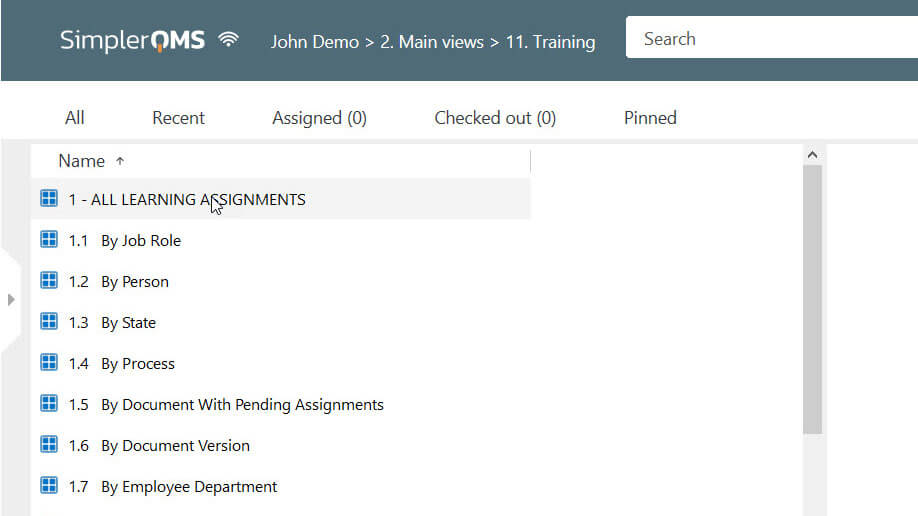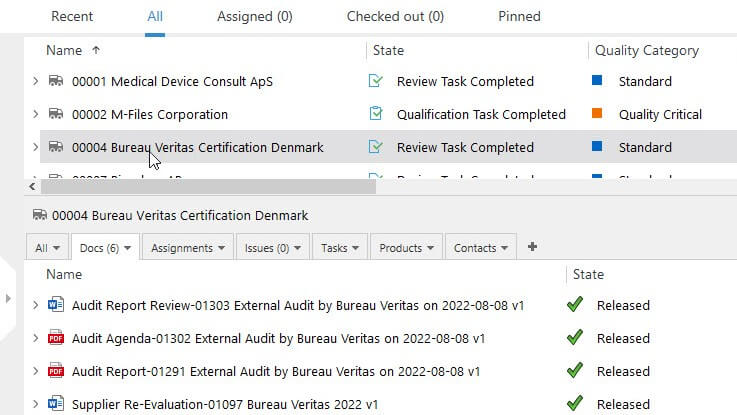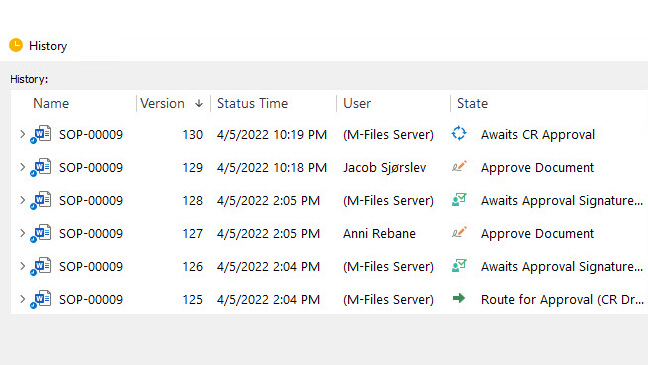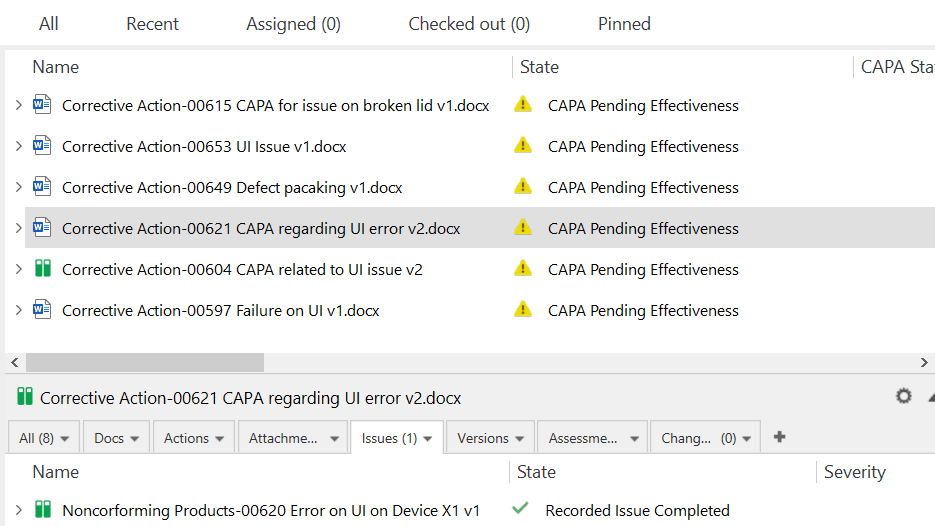The ISO 15189:2022 is an international standard that specifies the requirements for quality and competence in medical laboratories.
The medical laboratory is essential to patient care since decisions on patient treatment are made based on laboratory results. The standard provides a structure that enables these organizations to consistently develop their quality management systems (QMS) and assess their own competence.
In this article, we will discuss what the ISO 15189:2022 standard is all about, its purpose and requirements, and how an electronic QMS can help medical laboratories achieve compliance, including some case examples.
Although laboratories can achieve compliance with Life Science requirements using paper-based and hybrid QMS, having an electronic QMS (eQMS) helps to streamline quality processes.
SimplerQMS provides a complete eQMS solution. We provide support to medical laboratories of all sizes in implementing a quality management system that has features for document control, change control, training management, supplier management, equipment management, deviation and non-conformance management, complaint handling, and CAPA management.
Request a free personalized demo to talk to our experts and learn more about how SimplerQMS can help your company.
Learn about the ISO 15189:2022 standard by exploring these topics:
- What Is the ISO 15189:2022 Standard?
- Why Is the ISO 15189:2022 Important?
- Benefits of Being Compliant With the ISO 15189:2022
- Key Requirements for the ISO 15189:2022 Compliance
- The Role of QMS Software in Supporting Compliance with the ISO 15189:2022
- Frequently Asked Questions About the ISO 15189:2022
What Is the ISO 15189:2022 Standard?
The ISO 15189:2022 is an international standard that establishes requirements for quality and competence in medical laboratories. It contains many requisites, including planning and implementing actions to address risks and opportunities for improvement of the system and processes.
The standard can be used for several healthcare services, such as medical laboratories, diagnostic imaging, respiratory therapy, physiological sciences, blood banks, and transfusion.
The goal of the ISO 15189:2022 is to promote patient well-being and satisfaction by improving the trust that their medical laboratories are competent and quality-assured.
For that, the requirements comprehend all aspects of QMS in a medical laboratory, including sample collection and handling, risk management, employee competence requirements, metrological traceability of results, waste disposal, and so on.
This standard is based on the ISO 9001:2015 regarding general requirements for QMS, focusing on medical laboratories, as well as on the ISO 17025:2017 regarding testing and calibration competence requirements for laboratories to ensure equipment accuracy.
Furthermore, the ISO 15189:2022 incorporates and replaces the requirements for point-of-care testing (POCT), previously in the ISO 22870:2016. These requirements are intended for any test performed at or near a patient and at the site where care or treatment is provided, such as blood glucose monitoring and home pregnancy tests.
Note that the ISO 15189:2022 per se is not a mandatory standard but can be used to recognize the competence of medical laboratories by patients, customers, and regulatory authorities.
However, the European Federation of Clinical Chemistry and Laboratory Medicine (EFLM) survey on the accreditation process in European countries shows that some countries, such as France and Hungary, decided to integrate this standard as a mandatory requirement for all fields of laboratory medicine.
Other countries use it as a requirement for partial areas, like Belgium for molecular biology tests, Ireland for immunohematology and blood transfusion, and Lithuania for biochemistry and hematology.
In the United States, Clinical Laboratory Improvement Amendments (CLIA) requirements, expressed in the FDA 42 CFR Part 493, specify the requirements that all laboratories must meet to be certified to perform human testing.
Although the ISO 15189:2022 and the FDA 42 CFR Part 493 can be comparable in many aspects, this standard is not present in the FDA Recognized Consensus Standards, so it cannot replace a CLIA certification.
If you are a medical laboratory, please always refer to the applicable regulation in your country.
As described further in the article, various requirements related to QMS are outlined in the ISO 15189:2022. Paper-based or hybrid QMS systems can be used to support achieving compliance with regulatory standards, depending on the medical laboratory size and available resources to do all the manual work.
However, an eQMS helps streamline processes and offers more efficient support to achieve compliance with life science requirements.
SimplerQMS offers eQMS software that helps clinical and medical laboratories to achieve and maintain compliance with the ISO 15189:2022. It helps manage and document processes related to quality management, compliance, and competence across different departments in a paperless way.
Why Is the ISO 15189:2022 Important?
The ISO 15189:2022 standard is important because it sets medical laboratories’ quality and competence requirements. These two components are crucial to consistently achieving accurate and reliable results.
Patients’ treatment depends on laboratory results, and inaccuracies can lead to significant health problems. The ISO 15189:2022 facilitates harmonizing methods and procedures to provide patients with the same high level of care in any medical organization worldwide.
The standard helps improve medical laboratory credibility since complying with the requirements indicates that organizations have efficient and accurate processes in place.
In addition, the ISO 15189:2022 is essential for laboratory workers’ safety. Hazardous materials are often present in laboratories, so proper protection is necessary. The standard also outlines requirements regarding facilities and environmental conditions to help ensure that the personnel operating in the medical laboratory is not exposed to microbial contamination, radiation, humidity, temperature, sound, vibration, etc.
Benefits of Being Compliant With the ISO 15189:2022
The ISO 15189:2022 compliance provides many benefits to medical laboratories.
Overall, it is a useful approach to add credibility to your organization by demonstrating that products and services meet the expectations of customers and stakeholders regarding quality and competence.
Other benefits of the ISO 15189:2022 compliance include the following:
Increased Effectiveness of QMS
Complying with the requirements of this standard indicates that medical laboratories have an effective quality management system in place. Quality indicators can be used to evaluate performance during pre-examination, examination, and post-examination processes to drive continuous improvement.
Quality indicators, such as complaints and the number of CAPAs, are used to evaluate the performance of processes to drive continuous improvement, for instance.
For example, medical laboratories can investigate how many patient samples have been improperly collected, compare them to the total number of samples received, and then determine a threshold. When the threshold is reached, retraining of the staff takes place.
Risk Reduction
The ISO 15189:2022 provides a framework that, between many benefits, allows medical laboratories to identify and manage risk. Planning actions concerning potential risks helps to reduce harm to patients, laboratory personnel, the public, and the environment.
Higher Customer Satisfaction
With well-rounded and documented processes, activities are more likely to be carried out with competence and on time to meet all patients’ needs.
This way, patients trust medical laboratories to manage their data with impartiality and confidentiality while providing accurate results.
International Recognition
The ISO 15189:2022 compliance indicates that medical laboratories provide the same secure, competent, and high-quality services worldwide.
This standard is integrated into some countries as a mandatory requirement, making test results from the ISO 15189:2022 compliant and certified medical laboratories accepted internationally.
For example, some countries require travelers from tuberculosis (TB) endemic regions to provide a negative TB test to apply for a visa. To be accepted overseas, these tests must be performed by the ISO 15189:2022 compliant and certified laboratory.
Cost-Saving Processes
Compliance with the ISO 15189:2022 requirements demonstrates that the medical laboratory’s processes are efficient, providing accurate test results. By ensuring results are valid, laboratories could also save costs related to re-testing.
Overall, process improvement can lead to fewer errors and waste, enabling long-term cost savings.
Key Requirements for the ISO 15189:2022 Compliance
The ISO 15189:2022 is the fourth edition of the standard and has some improvements from the 2012 version.
In this standard, medical laboratories can find a greater emphasis on risk management, requirements for point-of-care testing (POCT), and an alignment with the ISO 17025:2017 that resulted in the incorporation of management requirements.
NOTE
Further in this article, we will discuss only some of the ISO 15189:2022 sections related to QMS. The entire standard is much more detailed. The information here is for educational purposes only.
If you are a medical laboratory, please always refer to the complete ISO 15189:2022 standard.
Sections 1 to 3 are related to the scope, normative references, and terms and definitions, respectively. This article will not focus on these sections.
If you want to learn more, please refer to the complete ISO 15189:2022 standard.
Confidentiality (Section 4.2)
Medical laboratories must manage all patient information given during examination with privacy and confidentiality. Relevant information about the patient’s well-being can be made available to other health professionals at the patient’s request.
For that, laboratories need to implement processes to ensure patient data can only be accessed by specific personnel.
Using a system with robust document controls, like SimplerQMS, medical laboratories can easily protect patient data and ensure its confidentiality. SimplerQMS software can set up document access levels by relating specific people to relevant documents, ensuring no unauthorized access to patient data.
The system allows laboratories to store all information in one place, a cloud-based system, eliminating the need for physical storage and the possibility of lost documents.
Recommended Reading: Laboratory Document Control: A Simple (But Complete) Guide
Quality Management (Section 5.4.2)
All medical laboratories that comply with the ISO 15189:2022 must have a QMS in place. It also helps improve laboratories’ overall performance and provides a sound basis for sustainable development initiatives.
For example, organizations must establish, document, implement and maintain laboratory QMS documentation regarding processes, systems, and records. Documents include policies, procedures, work instructions, and records to support the execution of activities.
It is possible to utilize a paper-based or hybrid QMS, depending on the size and resources available to the laboratory. However, an eQMS can streamline processes and activities involved in the quality and accuracy of test results.
SimplerQMS provides a complete QMS software solution designed specifically for life science industries. The system comes with pre-configured workflows, a complementary template package, and all core QMS modules, making the transition to an electronic QMS simpler and faster.
Recommended Reading: Laboratory Quality Management System (QMS)
Risk Management (Section 5.6)
Laboratory management must plan and implement processes for identifying potential harm to patients and opportunities to improve patient care.
Additionally, to this standard, medical laboratories can refer to the ISO 22367:2020, which provides more details for managing risk in medical laboratories, and the ISO 35001:2019 establishes the biorisk management principles.
Laboratories can also benefit from risk management capabilities built into an eQMS solution,1 like SimplerQMS. It helps medical organizations assess and document potential risks, prioritize them according to severity level, and assign actions to reduce the risk.
For example, a potential risk associated with sample testing is temperature fluctuations in refrigerators where samples are stored. Sample storage condition has an effect on the integrity of test results. The risk management plan should include an SOP for monitoring the temperature parameters of refrigerators.
Another example is the disposal of biological waste. Every sample has the potential risk of contamination, and therefore proper procedures for waste disposal must be implemented to protect the health of employees.
Continuing Education and Professional Development (Section 6.2.4)
The ISO 15189:2022 establishes that an education program needs to be available to personnel in management and technical processes.
Medical laboratories must have processes to determine the competence of personnel performing work affecting service quality.
Employee training management solution, an integral part of a complete eQMS solution, supports laboratories in achieving efficient, well-documented, and compliant training processes.
The system supports the assigning of training activities, sends email notifications and reminders for scheduled training, allows you to evaluate the effectiveness of training provided via quizzes, and tracks the progress of each trainee.

Equipment Management (Section 6.4)
Laboratory equipment must be appropriately handled, used, and maintained to ensure functionality and prevent contamination of personnel and results.
SimplerQMS also offers equipment management capabilities to help medical laboratories streamline equipment management processes, including calibration activities.
For instance, an ultracentrifuge must be calibrated to ensure the rotation frequency is maintained in all tests. SimplerQMS can support laboratories in setting recalibration schedules with automatic email notifications before due dates to assigned employees.
All documents related to the equipment can be easily accessed in the equipment menu, such as work instructions, calibration SOPs, CAPAs, logs, and so on.
Externally Provided Products and Services (Section 6.8)
The ISO 15189:2022 specifies requirements for supplier services that affect laboratory activities. For instance, medical laboratories must have processes to shortlist, qualify, select, onboard, and periodically evaluate suppliers’ performance.
Imagine that a medical laboratory needs to hire a pipette calibration service from another organization to ensure the volume of reagent used in the sample processing is consistently accurate. In such a case, it would be necessary to shortlist possible calibration companies, select one that complies with the regulatory requirements, and onboard it into the laboratory management system.
SimplerQMS helps organizations manage all supplier management-related processes and documents, such as contract, survey, evaluation, and certificate management, in single cloud-based storage for easy access by authorized users.
Approved supplier lists (ASL) can be easily created and managed in the system to overview the current status of suppliers regarding certifications and more. This also provides evidence that external products and services meet the laboratory’s established criteria.

Complaints (Section 7.7)
Medical laboratories must have a process for handling complaints. It includes tracking and recording the complaint and the actions to solve it.
For instance, the resolution of complaints needs to be reviewed and approved by staff not involved in the complaint issue to guarantee impartiality.
Using an eQMS facilitates complaint management processes. With a solution such as SimplerQMS, medical laboratories can manage all complaints in one cloud-based system capable of linking all relevant documents and defining access levels to protect documents from unauthorized views.
You can initiate a complaint from a customer file and escalate it to a CAPA, if necessary while having all these documents and processes easily related with just a few clicks.
Control of Management System Documents (Section 8.3)
Medical laboratories must control all internal and external documents.
These documents need to be uniquely identified to ensure traceability, periodically reviewed, and protected from unauthorized access. Also, all changes need to be tracked, and up-to-date versions of applicable documents need to be available for the personnel.
Clinical and medical activities generate a high volume of data and documents. It is necessary to implement document control tools to manage these documents efficiently.
For instance, pH meters must be cleaned and calibrated according to an SOP. The laboratory staff can miss the current version of the SOP, especially if it is only available in paper form. With an eQMS, medical laboratories can track and view the status of all documents in the system.
By implementing an eQMS with effective document control software like SimplerQMS, laboratories can streamline document creation using document templates. Only the current version of the document can be accessed, preventing obsolete documents from being used.
Medical organizations also need to control modifications made to existing documents, handle change request approval, and manage change implementation. With the SimplerQMS change control management module, medical laboratories can easily manage changes to their documents, processes, products, and templates.

Nonconformities and Corrective Actions (Section 8.7)
The ISO 15189:2022 outlines the actions in case of quality events.
Medical laboratories need to identify the cause of the issue and implement steps to ensure it does not occur again. These measures can be escalated to preventive and corrective actions (CAPA) if the laboratory seems fit.
For instance, if the equipment was calibrated but the calibration label was not updated. A CAPA can implement a checklist for the calibration procedure with an “update calibration status” item as a final step.
Using QMS software simplifies these processes. SimplerQMS non-conformance and CAPA modules help to ensure that all nonconformities (e.g., customer complaints, audit findings) are recorded, and the necessary actions are tracked. The system allows you to assign tasks and set timelines for completion.

Recommended Reading
The Role of QMS Software in Supporting Compliance with the ISO 15189:2022
Medical laboratories must have processes to ensure the validity and accuracy of test results. For that, they can comply with the requirements for quality and competence specified in the ISO 15189:2022 standard.
Using paper-based or hybrid QMS can be viable for small medical laboratories with adequate resources to handle the manual paperwork. However, all sizes of medical organizations can benefit from an eQMS solution.
SimplerQMS provides an integrated eQMS for medical laboratories to help achieve compliance with the ISO 15189:2022 requirements.
The QMS software facilitates the documentation of all processes and stores all data in one secure cloud-based system. Medical laboratories can determine access levels to protect patients’ confidential records and share them with other healthcare providers from anywhere.
SimplerQMS solution offers core QMS modules to streamline tasks, such as SOP creation, notifications, employee training, document changes, CAPA, audits, document collection, and so on.
Having an eQMS in place not only supports the ISO 15189:2022 compliance but also presents economic benefits.
If you are interested in learning more about whether eQMS software is the right solution for your organization, you can download our free eQMS Software Business Case template.
You will receive a spreadsheet with all the necessary information and calculations to help you understand the financial impact of investing in quality management software.
Frequently Asked Questions About the ISO 15189:2022
Is the ISO 15189:2022 Mandatory?
Compliance with the ISO 15189:2022 is voluntary, however, certain countries may require certification to this standard as it is internationally recognized and agreed upon by experts. It is used to recognize the quality and competence of medical laboratories by patients and regulatory authorities in some countries, such as France, Hungary, Belgium, Germany, and more.
If you are a medical laboratory, always check your national regulation to confirm if this standard applies to you!
Who Uses the ISO 15189:2022 Standard?
The ISO 15189:2022 is used by medical laboratories in developing their management systems and assessing their competence.
This standard is also utilized to confirm or recognize the competence of medical laboratories by laboratory users, regulatory authorities, and accreditation bodies.
An institution is considered a medical laboratory if it is responsible for testing human samples. These include microbiological, immunological, biochemical, cytological, and other tests.
What Is the Difference Between the ISO 17025:2017 and the ISO 15189:2022?
The main difference between the ISO 17025:2017 and the ISO 15189:2022 is the focus on patient and medical care.
The ISO 17025:2017 establishes requirements for the competence of general testing and calibration laboratories.
The ISO 15189:2022 specifies the requirements for quality and competence in medical laboratories. It applies to laboratories where human samples are tested.
For instance, a complete human blood count test is performed at the ISO 15189:2022 certified medical laboratory. In comparison, a rabies test for dogs can the carried out at the ISO 17025:2017 certified laboratory.
Is the ISO 15189:2022 the Same as CLIA?
Although the ISO 15189:2022 and US Clinical Laboratory Improvement Amendments (CLIA) can be comparable regarding laboratory conditions to perform human testing, they are not the same.
The specific regulations for medical laboratories to comply with CLIA are found in the FDA 42 CFR Part 493.
Certification to the ISO 15189:2022 does not meet the FDA 42 CFR Part 493 requirements and cannot replace a CLIA certification in the US market.
Final Thoughts
Medical laboratories aim to promote patients’ welfare and satisfaction by providing competent laboratory services and accurate test results.
The ISO 15189:2022 is an international standard that specifies medical laboratories’ quality and competence requirements. Laboratories that comply with this standard demonstrate the ability to provide services that consistently meet customer and applicable regulations.
Maintaining medical laboratory documentation always updated and compliant can be a complex process involving a high volume of information. Having a robust QMS is essential to manage quality management processes.
Paper-based and hybrid QMS can be used by small laboratories with enough resources. However, it can present challenges, such as human errors, lost documents, time-consuming audits, the need for physical storage, etc.
A straightforward solution is an eQMS solution made specifically for life sciences. QMS software by SimplerQMS supports medical laboratories and other companies in the life science industry, in streamlining quality management processes.
SimplerQMS offers a complete solution with core life science QMS modules, such as document control, audit management, supplier management, equipment management, non-conformance management, CAPA management, and much more.
If you are interested in learning more about our eQMS solution and how it can help you make compliance with the ISO 15189:2022 easier, book your free demo with one of our quality solution experts today.